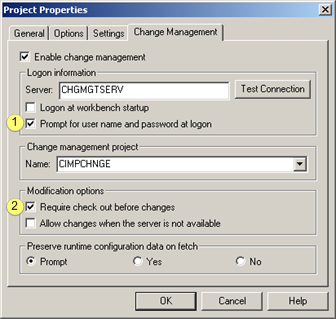|
Case description. |
|
|
CIMPLICITY project configuration. |
|
|
Managed characteristics configuration. |
|
|
Configuration changes guidelines. |
|
|
Exceptions. |
Case Description
![]() Multiple users use Proficy Change
Management.
Multiple users use Proficy Change
Management.
![]() Users are using the same copy of
the project on a shared drive.
Users are using the same copy of
the project on a shared drive.
CIMPLICITY Project Configuration
Create a project in CIMPLICITY.
Add all of the users who will need access to CIMPLICITY and/or Proficy Change Management to the new project.
Configure the CIMPLICITY project to perform according to your system specifications.
Managed Characteristics Configuration
Select the Change Management tab in the Project Properties dialog box.
Do the following.

|
1 |
PCM user names and passwords vs. CIMPLICITY user names and passwords. |
|
|
|
CIMPLICITY/PCM user names and passwords are not the same. |
|
|
|
CIMPLICITY/PCM user names and passwords are the same. |
|
|
2 |
Check Require check out before changes. |
|
Add the CIMPLICITY project to the Change Management server.
Configuration Changes Guidelines
Always follow these guidelines when performing configuration changes:
![]() Always close all configuration
applications before performing a check in operation, when
performing configuration transactions.
Always close all configuration
applications before performing a check in operation, when
performing configuration transactions.
![]() Perform a check out of the item(s)
before beginning application changes
Perform a check out of the item(s)
before beginning application changes
![]() Never check Don't overwrite local files with managed
copy when performing a check out operation,
Never check Don't overwrite local files with managed
copy when performing a check out operation,
![]() Never check Don't overwrite local files with managed
copy when performing an undo check out.
Never check Don't overwrite local files with managed
copy when performing an undo check out.
![]() Never share PCM user names with different
users.
Never share PCM user names with different
users.
Failure to follow these instructions can result in one user overwriting another user’s changes or an incoherent project as a result of concurrent changes.
|
1. Best practices: Initial development. |